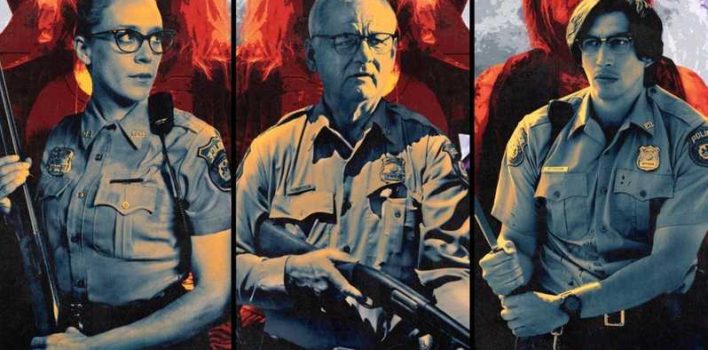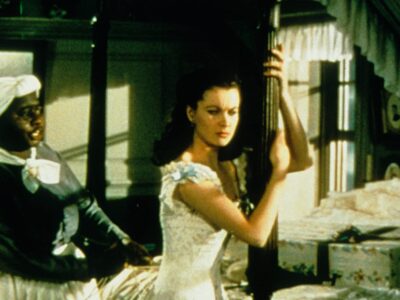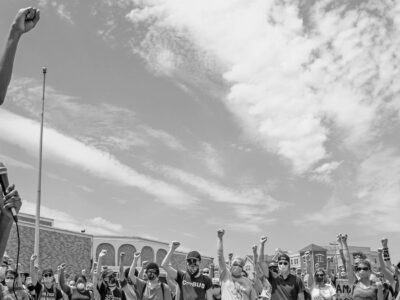How Culture Has Killed the Zombie: The Dead Don’t Die and the Death of Meaning
“[George Romero] turns the whole concept into something completely different. You can’t control the zombies. They are out of control. Generally, monsters — vampires, Frankenstein, Godzilla, whatever — they are outside the social structure. They are a danger to it, they are threatening it. With Romero, man, the zombies come from the social structure. They’re something that’s failed in the system. They’re the result of the social structure falling apart. They’re eating it from within.”
– Interview with Jim Jarmusch in Rolling Stone
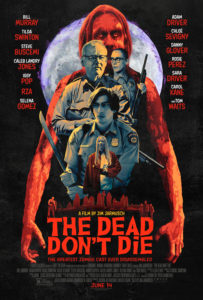 Here is a brief history of the zombie subgenre of horror in five titles:
Here is a brief history of the zombie subgenre of horror in five titles:
White Zombie (1932)
Night of the Living Dead (1968)
28 Days Later… (2002)
Shaun of the Dead (2004)
The Dead Don’t Die (2019)
If you watch these five films then you have the full breadth of zombie cinema. White Zombie was the first popular appearance of brainwashed humans being controlled by forms of South American or African voodoo. Many of these films were a—perhaps sometimes unintentional—critique of colonial control, the literal making of slaves to do the bidding of those who had power over them. It encapsulates the early cinematic zombie imagination that held sway until 1968 when George Romero made the second film in our list, The Night of the Living Dead.
This film shifted the cultural imagination away from colonial conquest to the ghosts of colonial remnants haunting those same powers. We are not entirely clear what made the zombies rise up in Night except for a few ideas given by newscasts in the background of the film. Something supernatural, perhaps. Nonetheless, Romero’s film, whether he was cognizant of it at the time or not (he has said that he wasn’t in a few interviews), made a movie that addressed the intricacies of racial dynamics and the plight of the black community in modern American society. Plus, he used Duane Jones, a black man, as the lead character of the movie. He survives the whole film fighting off zombies as well as the white people who are holed up in a farmhouse with him only to be shot by the police who cannot distinguish a black man from a monster. Sound familiar?
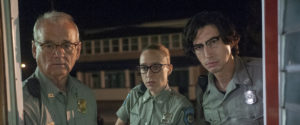 Fast forward to 2002 with the release of Danny Boyle’s 28 Days Later… and the introduction of the new phase of the zombie: the rage of infection. Science gone wrong, experiments on animals transitioning over to humans and causing a pandemic of fast-moving, enraged zombies. A good portion of zombie cinema has taken this form since Boyle’s film. In a sense, one could say that there is a fear of what man hath wrought by messing with nature, or the unintended consequences of finding cures. It also invited the feeling of isolation that would affect the survivors in the midst of the apocalypse. The existential dread that had been present in the subgenre was beginning to come to the surface more fully.
Fast forward to 2002 with the release of Danny Boyle’s 28 Days Later… and the introduction of the new phase of the zombie: the rage of infection. Science gone wrong, experiments on animals transitioning over to humans and causing a pandemic of fast-moving, enraged zombies. A good portion of zombie cinema has taken this form since Boyle’s film. In a sense, one could say that there is a fear of what man hath wrought by messing with nature, or the unintended consequences of finding cures. It also invited the feeling of isolation that would affect the survivors in the midst of the apocalypse. The existential dread that had been present in the subgenre was beginning to come to the surface more fully.
This dread finds its fullness realized in the Edgar Wright horror-comedy Shaun of the Dead. Where Romero’s films looked at social ills like racism, consumerism, and authoritarianism, among other ideas, Wright’s film was more interested in the existential elements in which those social ills could take residence in humanity. Shaun and his friends and family are already like zombies in their everyday existence. The rituals of their lives are filled with their own selfish wants and desires without concern for the world outside of them that is literally going to hell. In a sense, the physical zombies become a mirror to them in order to wake them from their stupor. The film is quite humorous, but the critique is pointed if one is paying attention.
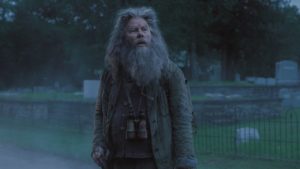 All of this history of the zombie subgenre brings me to Jim Jarmusch’s new zombie film, The Dead Don’t Die, which doubles as a poetic expression of the oversaturation of and the unlikely demise of the zombie genre any time soon. Jarmusch does not care for zombies; as a matter of fact he kind of even hates them—as you can read in the interview linked above. Sometimes it takes an outsider, a hater, to draw what I think is singularly the greatest words said about the subgenre: Zombies are “the result of the social structure falling apart. They’re eating it from within.” This, folks, is the history of the zombie in a perfectly succinct quote. So what does Jarmusch do about zombies? He makes his own zombie film with regulars from his other films. Within the history of the subgenre, The Dead Don’t Die feels like the death of the zombie. It may not actually end anytime soon, but this movie has wrested any final meaning from further zombie fare from here on out. And I couldn’t be happier.
All of this history of the zombie subgenre brings me to Jim Jarmusch’s new zombie film, The Dead Don’t Die, which doubles as a poetic expression of the oversaturation of and the unlikely demise of the zombie genre any time soon. Jarmusch does not care for zombies; as a matter of fact he kind of even hates them—as you can read in the interview linked above. Sometimes it takes an outsider, a hater, to draw what I think is singularly the greatest words said about the subgenre: Zombies are “the result of the social structure falling apart. They’re eating it from within.” This, folks, is the history of the zombie in a perfectly succinct quote. So what does Jarmusch do about zombies? He makes his own zombie film with regulars from his other films. Within the history of the subgenre, The Dead Don’t Die feels like the death of the zombie. It may not actually end anytime soon, but this movie has wrested any final meaning from further zombie fare from here on out. And I couldn’t be happier.
Critics and general audiences alike seem to be largely down on this film, and I am not at all surprised; seeing as how the film puts the “dead” in deadpan and all the “far” in farce. Adam Driver and Bill Murray are our small-town cops who drive around during the day confronting issues like a homeless—yet poetic—forest dweller (Tom Waits) for killing a chicken that belongs to a right wing farmer who wears a “Make America White Again” trucker hat (Steve Buscemi). When they aren’t passively enforcing the law, they are visiting with the local characters of Centerville. When the zombies come, they are not scared, more befuddled, by their plight. Ronnie (Driver) says from the outset after he sees the gruesome scene at the diner, that this “is going to end badly.” He repeats this throughout the film, and each time Cliff looks at him with exasperation as if he doesn’t need this kind of negativity in this situation. It turns out that his frustration lies more in the realm of his role in the story.
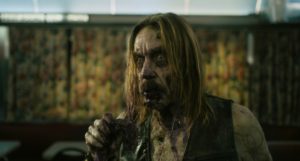 The zombies are made to rise from the dead due to the fracking of the ice caps which has shifted the earth more and more off its axis. The moon has a purple-pink haze surrounding it and like the waves of the ocean, the dead flow out from the ground. This is an angry zombie film that finds its critique in the human indifference towards what Jarmusch—and many climate scientists—considers to be their eventual extinction. Instead, people are more concerned with the perpetual negotiation of their existential dread through Capitalistic consumerism.
The zombies are made to rise from the dead due to the fracking of the ice caps which has shifted the earth more and more off its axis. The moon has a purple-pink haze surrounding it and like the waves of the ocean, the dead flow out from the ground. This is an angry zombie film that finds its critique in the human indifference towards what Jarmusch—and many climate scientists—considers to be their eventual extinction. Instead, people are more concerned with the perpetual negotiation of their existential dread through Capitalistic consumerism.
There is a common theme of repetition in the film. Whether it is the film’s theme song (sung by the great Sturgill Simpson, who makes an appearance in the film), or the recitation of the police’s explanation of what happened at the diner, or Driver’s doom prophecy about how this scenario is going to end. It seems that the seething anger beneath this film is directed at humanity’s repetitive liturgies of apathy, a self-imposed blindness towards the very things that will kill us.
Don’t let all of this talk keep you from understanding that this is a comedy through and through; but it is one that will only appeal to those who have exercised their stomach muscles with a mixture of deadpan and slapstick akin to British comedy. I have no doubt that Jarmusch had a script for this film, but the delivery of dialogue between the characters is so riddled with unusual pauses that it has the quality of really poorly executed improvisation. The silences are always awkward. The emotions never quite in sync with the spaces where the characters find themselves. And I think this is all intentional. And hilarious.
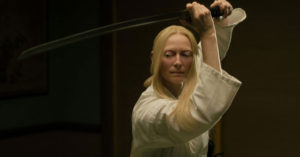 The film references elements from the Romero films, and Star Wars, and the Wu-Tang Clan (RZA plays the “WuPS driver”) among other broad cultural allusions. And while recognizing these can be a blast and lead to chuckles, it somewhat feels more damning in that we are quick to recognize the culture which we consume—or which consumes us—and not those things in the world that are leading to our very demise. This is just one of the oxymorons that finds residence in this film.
The film references elements from the Romero films, and Star Wars, and the Wu-Tang Clan (RZA plays the “WuPS driver”) among other broad cultural allusions. And while recognizing these can be a blast and lead to chuckles, it somewhat feels more damning in that we are quick to recognize the culture which we consume—or which consumes us—and not those things in the world that are leading to our very demise. This is just one of the oxymorons that finds residence in this film.
The reason The Dead Don’t Die is not getting the love it deserves is because it refuses to take the zombie formula seriously. As a matter of fact, it is actively killing it off with its grand deconstruction of its subgenre structures. Jarmusch recognized the fullness of meaning that has inhabited the subgenre since its inception, and yet people would rather forget the meaning of these films in order to render them as conceptual husks of themselves to be consumed as cultural content. I know that I, for one, will not be able to watch another zombie film without reference to this film from now on, because Jarmusch has made a compelling case that the zombie as symbol is dead even if the dead refuse to die.


